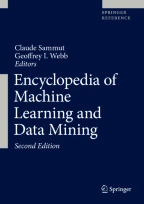Definition
Higher-order logic is a logic that admits so-called higher-order functions, which are functions that can have functions as arguments or return a function as a result. The expressive power that comes from higher-order functions makes the logic highly suitable for representing individuals, predicates, features, background theories, and hypotheses and performing the necessary reasoning, in machine learning applications.
Motivation and Background
Machine learning tasks naturally require knowledge representation and reasoning. The individuals that are the subject of learning, the training examples, the features, the background theory, and the hypothesis languages all have to be represented. Furthermore, reasoning, usually in the form of computation, has to be performed.
Logic is a convenient formalism in which knowledge representation and reasoning can be carried out; indeed, it was developed exactly for this purpose. For machine learning applications, quantification over...
Access this chapter
Tax calculation will be finalised at checkout
Purchases are for personal use only
Recommended Reading
Andrews PB (2002) An introduction to mathematical logic and type theory: to truth through proof, 3rd edn. Kluwer Academic, Dordrecht
Bowers AF, Giraud-Carrier C, Lloyd JW (2000) Classification of individuals with complex structure. In: Langley P (ed) Machine learning: proceedings of the seventeenth international conference (ICML 2000), Stanford. Morgan Kaufmann, Stanford, pp 81–88
Church A (1940) A formulation of the simple theory of types. J Symb Log 5:56–68
Dietzen S, Pfenning F (1992) Higher-order and modal logic as a framework for explanation-based generalization. Mach Learn 9:23–55
Farmer W (2008) The seven virtues of simple type theory. J Appl Log 6(3):267–286
Feng C, Muggleton SH (1992) Towards inductive generalisation in higher order logic. In: Sleeman D, Edwards P (eds) Proceedings of the ninth international workshop on machine learning. Morgan Kaufmann, San Mateo, pp 154–162
Fitting M (2002) Types, tableaus, and Gödel’s god. Kluwer Academic, Dordrecht
Flach P, Giraud-Carrier C, Lloyd JW (1998) Strongly typed inductive concept learning. In: Page D (ed) Inductive logic programming, 8th international conference, ILP-98, Madison. Lecture notes in artificial intelligence, vol 1446. Springer, Berlin, pp 185–194
Gärtner T, Lloyd JW, Flach P (2004) Kernels and distances for structured data. Mach Learn 57(3):205–232
Gyftodimos E, Flach P (2005) Combining Bayesian networks with higher-order data representations. In: Proceedings of 6th international symposium on intelligent data analysis (IDA 2005), Madrid. Lecture notes in computer science, vol 3646. Springer, Berlin, pp 145–156
Hanus M (ed) (2006) Curry: an integrated functional logic language. http://www.informatik.uni-kiel.de/~curry. Retrieved 21 Dec 2009
Henkin L (1950) Completeness in the theory of types. J Symb Log 15(2):81–91
Kennedy CJ, Giraud-Carrier C (1999) An evolutionary approach to concept learning with structured data. In: Proceedings of the fourth international conference on artificial neural networks and genetic algorithms (ICANNGA’99). Springer, Berlin, pp 331–366
Lloyd JW (2003) Logic for learning. Cognitive technologies. Springer, Berlin
Lu J, Harao M, Hagiya M (1998) Higher order generalization. In: JELIA ’98: proceedings of the European workshop on logics in artificial intelligence, Dagstuhl. Lecture notes in artificial intelligence, vol 1489. Springer, Berlin, pp 368–381
Muggleton S, Page CD (1994) Beyond first-order learning: inductive learning with higher-order logic. Technical report PRG-TR-13-94, Oxford University Computing Laboratory
Nadathur G, Miller DA (1998) Higher-order logic programming. In: Gabbay DM, Hogger CJ, Robinson JA (eds) The handbook of logic in artificial intelligence and logic programming, vol 5. Oxford University Press, Oxford, pp 499–590
Ng KS (2005a) Generalization behaviour of alkemic decision trees. In: Inductive logic programming, 15th international conference (ILP 2005), Bonn. Lecture notes in artificial intelligence, vol 3625. Springer, Berlin, pp 246–263
Ng KS (2005b) Learning comprehensible theories from structured data. PhD thesis, Computer Sciences Laboratory, The Australian National University
Ng KS (2006) (Agnostic) PAC learning concepts in higher-order logic. In: European conference on machine learning (ECML 2006), Berlin. Lecture notes in artificial intelligence, vol 4212. Springer, Berlin, pp 711–718
Ng KS, Lloyd JW, Uther WTB (2008) Probabilistic modelling, inference and learning using logical theories. Ann Math Artif Intell 54:159–205. doi:10.1007/s 10472-009-9136-7
Peyton Jones S (ed) (2003) Haskell 98 language and libraries: the revised report. Cambridge University Press, Cambridge
Wolfram DA (1993) The clausal theory of types. Cambridge University Press, Cambridge
Author information
Authors and Affiliations
Corresponding author
Editor information
Editors and Affiliations
Rights and permissions
Copyright information
© 2017 Springer Science+Business Media New York
About this entry
Cite this entry
Lloyd, J. (2017). Higher-Order Logic. In: Sammut, C., Webb, G.I. (eds) Encyclopedia of Machine Learning and Data Mining. Springer, Boston, MA. https://doi.org/10.1007/978-1-4899-7687-1_126
Download citation
DOI: https://doi.org/10.1007/978-1-4899-7687-1_126
Published:
Publisher Name: Springer, Boston, MA
Print ISBN: 978-1-4899-7685-7
Online ISBN: 978-1-4899-7687-1
eBook Packages: Computer ScienceReference Module Computer Science and Engineering
